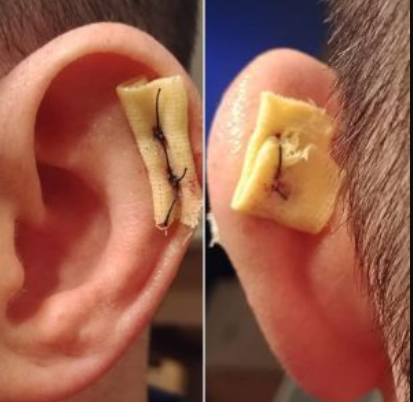
If you train BJJ, MMA, or wrestling, you may have noticed that some of your fellow athletes have funny-looking ears. They may look lumpy, swollen, or deformed, like a cauliflower. This condition is called cauliflower ear, and it is caused by repeated trauma to the ear cartilage. Whereas a few individuals may wear it as a badge of honor, others may discover it unattractive, excruciating, or indeed hurtful to their hearing.
So, what can you do to prevent cauliflower ears in BJJ? How can you treat it? And how can you heal it if you want to restore your normal ear shape? In this article, we will answer these questions and provide you with some useful tips on how to avoid, drain and heal cauliflower ear in BJJ.
What Is Cauliflower Ear And What Causes It?
Cauliflower ear is a deformity of the outer ear that occurs when the ear cartilage is damaged by blunt trauma. The trauma causes bleeding under the skin, which forms a pocket of blood called a hematoma. This hematoma separates the overlying skin from the cartilage and prevents blood flow and nutrients from the blood vessels from reaching the cartilage.
As a result, the cartilage dies and shrinks, and scar tissue forms around it. This gives the ear a lumpy and wrinkled cauliflower-like appearance.
Acute cauliflower ear can happen to anyone who suffers a blow to the ear, such as boxers, rugby players, or martial artists. However, it is especially common in grapplers who train in Brazilian Jiu-Jitsu, mixed martial arts, or wrestling.
This is because grapplers often experience friction and pressure on their ears during headlocks, chokes, escapes, or takedowns. The Gi material can also rub and scrape the ears and cause damage, blocking off the blood supply in the ear.
Some people are more prone to developing cauliflower ear injuries than others, depending on their genetics, specific risk factors, and the severity of blunt-force trauma.
How To Prevent Cauliflower Ears in Brazilian Jiu-Jitsu
The best way to prevent cauliflower ear in BJJ is to avoid trauma to the ear as much as possible. While it may sound simple, once you’re engulfed in a grappling exchange, this can become quite hard if you do not have a system of things to watch out for in place.
Here are a few of those:
- Adjust your rolling style. Try not to use too much pressure or force with your head when passing guard, controlling positions, or escaping chokes. Avoid getting your head stuck in tight spots where your ears can get folded or twisted. This is the most common way cauliflower ear occurs in grapplers. Tap early if you feel your ear is in danger of getting injured.
- Wear protective head gear. One of the most effective ways to prevent cauliflower ears is to wear a comfortable and durable ear guard that covers your ears and protects them from impact and friction. Choose protective headgear that fits well and does not interfere with your hearing or vision.
- Keep your ears clean and dry. Another way of preventing cauliflower ear is to avoid ear infections that can worsen the condition. Wash your ears with soap and water after every training session and dry them thoroughly. Strictly avoid wearing earrings or piercings that can irritate or injure your ears.
https://bjj-world.com/best-bjj-headgear-review/
How To Drain Cauliflower Ears In BJJ
If you notice any signs of cauliflower ear, such as swelling, bruising, pain, or loss of shape in your ear, you should act quickly before the blood clots and hardens. The sooner you treat it, the better your chances of preventing permanent deformity.
Here are some steps on treating acute cauliflower ear in BJJ:
- Seek professional help. The initial treatment is draining the ear. The safest and most effective way to drain the cauliflower ear is to go to a doctor or a nurse who can perform the procedure with sterile tools, local anesthetic, and proper technique. It is not recommended that you attempt to drain it yourself especially risking the use of unsterile tools such as needles or syringes that can cause infection or further damage.
- Follow the aftercare instructions. After draining the blood from your ear, you will need to apply pressure dressing, ice packs, and antibiotics as prescribed by your doctor. You will also need to keep the area clean and avoid further trauma until it heals completely.
How To Recover From Cauliflower Ear
If you have already developed cauliflower ear and want to restore your normal ear shape and function, you may need to consider surgery. However, surgery is not always necessary or recommended for everyone.
Here are some factors to consider before deciding on surgery:
- Rest your ears. Before opting for surgery, you should give your ears some time to heal naturally. Take a break from training until your ears are fully healed and no longer swollen or tender. Do not expose them to friction, heat, or moisture that can delay healing or cause infection.
- Monitor your ears. Check your ears regularly for signs of infection, inflammation, or recurrence of hematoma. If you notice any problems, consult your doctor immediately and follow their advice.
- Consider surgery. If you are unhappy with the appearance of your ears after they have healed naturally, you can opt for cosmetic surgery to restore the shape and function of an ear lobe or two. However, be aware of the risks, costs, and recovery time involved in corrective surgery.You will need to find a qualified plastic surgeon who has experience with cauliflower ear correction. You will also need to undergo anesthesia, incisions, stitches, bandages, drains, painkillers and antibiotics.
- Avoid any contact sports or activities that could injure your ears again for several weeks or months. You may also experience some swelling, bruising, numbness, or itching in your ears after surgery. Cauliflower ear severe symptoms might require repetitive surgeries and up to a year for results to become visible after the procedure(s).
How To Drain Cauliflower Ear At Home Step-By-Step
If you are tempted to drain cauliflower ear at home, you should re-think your decision. if you’re dead set on doing it yourself, at least make sure you know the correct steps and have at your disposal a cauliflower draining kit with the essential instruments.
5 Things You Need To Drain Your Cauliflower Ears
Before attempting to drain a cauliflower ear at home, you will need the following:
- Sterile needles: You will need a sterile needle to puncture the ear and drain the fluid. It is important to use a new, sterile needle every time to prevent infection.
- Alcohol or iodine solution: Before draining the fluid, you should clean the ear with an alcohol or iodine solution to reduce the risk of infection.
- Gloves: It is essential to wear gloves while draining cauliflower ear to prevent the spread of infection.
- Gauze or cotton balls: To stop the bleeding after draining the fluid, you will need gauze or cotton balls.
- Pain relief: Draining cauliflower ear can be painful, so it is advisable to have pain relief medication on hand.
Steps To Draining Cauliflower Ear At Home
If you notice signs of cauliflower ear in the early stages, such as pain, swelling, and redness, it is important to start treatment immediately.
Here are the steps to follow:
- Clean the ear: First, clean the affected area with an alcohol or iodine solution.
- Apply ice: Apply ice to the affected area for 10-15 minutes to reduce swelling.
- Drain the fluid: Using a sterile needle, puncture the ear and drain the fluid. Gently press on the ear to encourage the fluid to drain.
- Apply pressure: After draining the fluid, apply pressure with gauze or cotton balls to stop the bleeding.
- Monitor the ear: Keep a close eye on the ear to ensure it does not become infected. If you notice any signs of infection, such as fever or increased redness, consult a medical professional.
Safety Tips When Draining Cauliflower Ear On Your Own
When draining cauliflower ear, it is important to be gentle and patient. Avoid using excessive force or trying to extract too much fluid at once. Instead, take your time and use small, controlled movements.
It is also important to avoid inserting the needle too deeply or at the wrong angle. Make sure that you are using a sharp needle to minimize discomfort and ensure that the procedure is as quick and painless as possible. If you experience any resistance, it may be an indication that the needle is not in the right place, and you should stop immediately.
After draining the cauliflower ear, it is important to properly care for the wound to prevent infection. Clean the area thoroughly with soap and water and apply an antiseptic ointment. Use a sterile dressing to cover the wound and change it regularly.
If you feel any pain, swelling, or redness, get help from a doctor right away. It could mean you have an infection and need medical treatment.
Cauliflower Ear Draining FAQs
When To See A Doctor About Cauliflower Ear Draining?
It’s recommended to see a doctor as soon as possible if you suspect you have cauliflower ear. If the ear is swollen, painful, or red, it could be a sign of an infection, and a doctor can determine the best course of action. If you’re considering draining your cauliflower ear, it’s best to consult with a medical professional before attempting to do so on your own.
Should I Drain My Cauliflower Ear?
It’s important to consult with a medical professional before attempting to drain it on your own. They will be able to assess the extent of the injury and determine if draining is necessary. Improper draining can lead to further complications, so it’s essential to have a doctor or trained medical professional perform the procedure.
Do Cauliflower Ears Go Away?
Cauliflower ears do not go away on their own. Once the injury has occurred, the cartilage in the ear becomes deformed and can only be corrected through medical intervention. It’s important to treat cauliflower ears promptly to prevent permanent damage and disfigurement of the outer portion of the ear.
What Fluid Comes Out of Cauliflower Ear?
When a cauliflower ear is drained, the fluid that is released is typically a mixture of blood, pus, and other bodily fluids. The fluid can have a foul odor and is often accompanied by pain and swelling.
When Is It Too Late To Drain Cauliflower Ear?
It is always possible to remedy a cauliflower ear regardless of the time that has elapsed, but it is crucial to take prompt action in order to avoid irreversible harm. The longer the fluid accumulates, the more damage it can do to the ear cartilage, making it more difficult to correct the deformity.
What Happens If You Don’t Drain Your Cauliflower Ear?
If left untreated, cauliflower ears can lead to permanent disfigurement and affect your hearing to the level of serious hearing loss. The pressure from the fluid buildup can also cause pain and discomfort. Sometimes, the tissue in your ear can get hurt really bad and you might need surgery to fix it. It’s essential to treat cauliflower ear as soon as possible to prevent further complications.
Conclusion
Cauliflower ear is a common condition among BJJ practitioners that can affect their appearance, self-esteem, and hearing. However, it is not inevitable or irreversible. By following some simple tips on how to prevent, drain and heal cauliflower ears in BJJ, you can enjoy your sport without worrying about your ears.
If you’re worried about cauliflower ear, talk to a doctor or plastic surgeon to figure out what to do. Remember that protective gear goes a long way if you have a predisposition to developing the condition. Also, early treatment is crucial to prevent permanent deformity and complications. Lately, there are some scientists claiming they can fix cauliflower ears with simple injections. So let’s see what the future will bring. Till then keep your ears safe.
https://bjj-world.com/the-end-of-cauliflower-ears-revolutionary-injection-fixes-deformed-ears/


![Darce Choke Encyclopedia – Origins, Mechanics and Variations [2025] BJJ, choke, Brabo, BJJ Darce Choke, D'arce Choke, Darce BJJ Choke](https://bjj-world.com/wp-content/uploads/2017/11/JungPoirierLeeYahoo-218x150.jpg)













![X-Guard Trickery Kyle Sleeman DVD Review [2025] X-Guard Trickery Kyle Sleeman DVD Review](https://bjj-world.com/wp-content/uploads/2025/03/x-guard-trickery-kyle-sleeman-dvd-review-218x150.png)
![Countering with Crab Ride Anthony Budion DVD Review [2025] Countering with Crab Ride Anthony Budion DVD Review](https://bjj-world.com/wp-content/uploads/2025/03/countering-with-crab-ride-anthony-budion-dvd-review-218x150.png)
![Closet Closed Guard Craig Jones DVD Review [2025] Closet Closed Guard Craig Jones DVD Review](https://bjj-world.com/wp-content/uploads/2025/03/closet-closed-guard-craig-jones-dvd-review-218x150.png)
![Xanadu Back Takes Levi Jones-Leary DVD Review [2025] Xanadu Back Takes Levi Jones-Leary DVD Review](https://bjj-world.com/wp-content/uploads/2025/03/xanadu-back-takes-levi-jones-leary-dvd-review-218x150.png)

![No-Gi Grapplers Guide To Front Headlock Joel Bane DVD Review [2025] No-Gi Grapplers Guide To Front Headlock Joel Bane DVD Review](https://bjj-world.com/wp-content/uploads/2025/03/no-gi-front-headlock-joel-bane-dvd-review-218x150.png)


![10th Planet Leg Locks Jeremiah Vance DVD Review [2025] 10th Planet Leg Locks Jeremiah Vance DVD Review](https://bjj-world.com/wp-content/uploads/2025/01/10th-planet-leg-locks-jeremiah-vance-dvd-review-100x70.png)
![Full Guard Formula James Booth DVD Review [2025] Full Guard Formula James Booth DVD Review](https://bjj-world.com/wp-content/uploads/2025/02/full-guard-formula-james-booth-dvd-review-100x70.png)


![Flow Pressure Kauan Barboza DVD Review [2025] Flow Pressure Kauan Barboza DVD Review](https://bjj-world.com/wp-content/uploads/2025/02/flow-pressure-kauan-barboza-dvd-review-100x70.png)

![Reverse Armlock Magid Hage DVD Review [2024] Reverse Armlock Magid Hage DVD Review](https://bjj-world.com/wp-content/uploads/2024/12/reverse-armlock-magid-hage-dvd-review-100x70.png)

![Effectively Passing The Guard Luke Griffith DVD Review [2025] Effectively Passing The Guard Luke Griffith DVD Review](https://bjj-world.com/wp-content/uploads/2025/01/passing-the-guard-luke-griffith-dvd-review-100x70.png)
![Xanadu Back Takes Levi Jones-Leary DVD Review [2025] Xanadu Back Takes Levi Jones-Leary DVD Review](https://bjj-world.com/wp-content/uploads/2025/03/xanadu-back-takes-levi-jones-leary-dvd-review-100x70.png)
![Get Off My Legs Gringo Craig Jones DVD Review [2025] Get Off My Legs Gringo Craig Jones DVD Review](https://bjj-world.com/wp-content/uploads/2025/03/get-off-my-legs-gringo-craig-jones-dvd-review-100x70.png)



![Guard Busters Bill Cooper BJJ DVD Review [2025] Guard Busters Bill Cooper BJJ DVD Review](https://bjj-world.com/wp-content/uploads/2025/03/guard-busters-bill-cooper-bjj-dvd-review-100x70.png)
![Advantage Over Time Outside Passing Jozef Chen DVD Review [2025] Advantage Over Time Outside Passing Jozef Chen DVD Review](https://bjj-world.com/wp-content/uploads/2025/03/outside-passing-jozef-chen-dvd-review-100x70.png)
![The Whole Omoplata Enchilada Lyanne Perez DVD Review [2024] The Whole Omoplata Enchilada Lyanne Perez DVD Review](https://bjj-world.com/wp-content/uploads/2024/11/whole-omoplata-enchilada-lyanne-perez-dvd-review-100x70.png)

![Henry Akins Black Hole No-Gi Closed Guard DVD Review [2024] Henry Akins Black Hole No-Gi Closed Guard DVD Review](https://bjj-world.com/wp-content/uploads/2024/09/henry-akins-black-hole-no-gi-closed-guard-dvd-review-100x70.png)

![Crush The Guard Vagner Rocha DVD Review [2024] Crush The Guard Vagner Rocha DVD Review](https://bjj-world.com/wp-content/uploads/2024/10/crush-the-guard-vagner-rocha-dvd-review-100x70.png)

![Shotgun Aoki Locks Mateusz Szczecinski DVD Review [2025] Shotgun Aoki Locks Mateusz Szczecinski DVD Review](https://bjj-world.com/wp-content/uploads/2025/03/shotgun-aoki-locks-mateusz-szczecinski-dvd-review-100x70.png)



